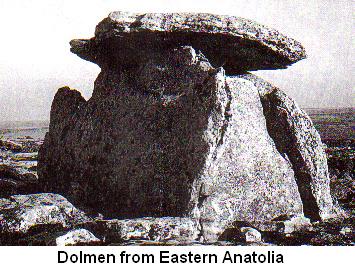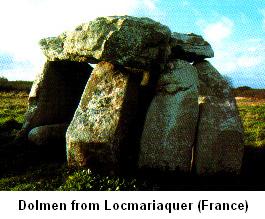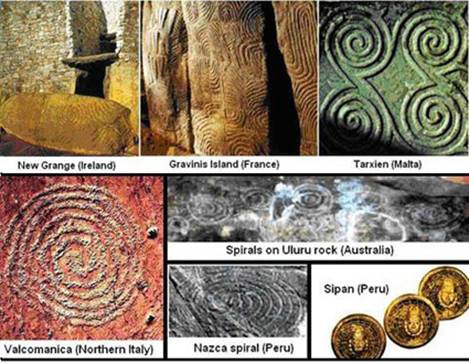|
The
western expansion of Asiatic people has been discussed in
several previous chapters. In 1967 the first calibrated
radiocarbon dates showed that our knowledge of early
civilizations should be revised towards a much earlier time
period. In an article entitled “Ancient Europe is Much Older
Than We Thought” it is said
(1):
We now know through radiocarbon dating that temples were under
construction in Malta before 3000 BC, before the Pyramids of
Egypt.
We find a clear correlation between the megaliths of Anatolia
and the ones of Western Europe. Dolmens and Menhirs found in
eastern Anatolia are similar to the ones found in western
France and northern England. A total of 110 dolmens have been
investigated in a large region covering from Ankara to Kars,
in Turkey (2).
Below we see such a dolmen which dates from several thousand
years BC. It is difficult to give an exact date for these
structures, because no organic remains were found within the
dolmens, but the article claims that they are older than the
Egyptian pyramids. From the size and weight of these granite
slabs we can guess that a lot of energy was spent to build
these structures, which were important and special for these
ancient people.

They may
also be tomb sites built for important tribe leaders. Their
pyramidal form is a clear symbol representing the memory of
Asiatic mountains on which kurgans were built, as mentioned in
Chapter 25, From Kurgans to
Pyramids. This culture of building circular graves
and cult centers has been recently discovered in Göbeklitepe –
Southern Turkey as discussed in Chapter 12,
The Anatolian Expansion.
The people
from the Asiatic kurgan culture were sun-worshippers and they
quite naturally followed the trajectory of the sun in the sky
moving towards the west. Wherever they went they kept the
habit of building circular cult centers and spirals
symbolizing the circular form of the sun. We find such
circular forms and cult centers in Malta, Spain, France,
Denmark, England, Scotland and Ireland. Below we see a dolmen
from Locmariaquer, Brittany – France. The dolmen has a
striking similarity to the Anatolian dolmens shown above. They
all have the same architectural structure of few uprights
topped by a large covering slab.

We also
find large circular structures which show that in time the
dolmens were replaced by large cult centers. It is still
believed that these cult centers were special places for
sun-worshiping. Stonehenge, for example, is a location where
thousands of people gather each year for celebrating the
rising sun during the summer solstice
(3).

Similar cult
centers are also found on Mediterranean islands. The
Brochtorff circle on the Gozo Island of Malta is a typical
example of this ancient culture. The worship-center shares
clear similarities with the recent find at Göbeklitepe –
Turkey. This cult center of Gozo is bounded by a stone circle
45 meters in diameter, similar to the ones surrounding the
kurgans found on the high peaks of the Altai Mountains (see
Chapter 23, The Issyk Kurgan).

Further
proof that these circular structures were cult centers built
by a sun-worshiping culture is the circular and spiral forms
found all over the world. Above we see some examples of such
spiral forms, reminding us the
Onkh or
Khno symbolism
discussed in Chapter 6,
Universal Symbols.
|